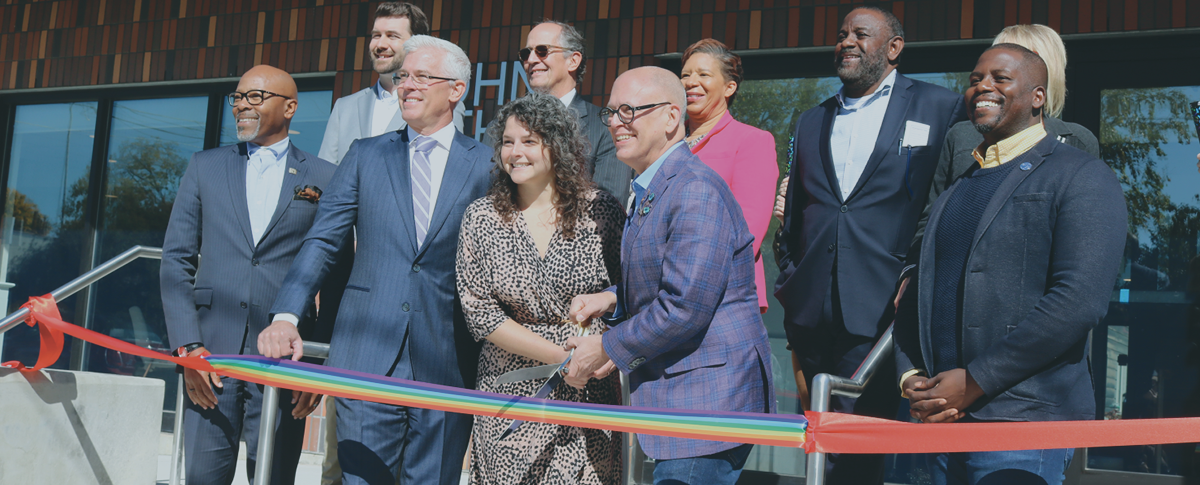Being a Good Neighbor
The 11 regional Banks within the Federal Home Loan Bank System are not just connected to the communities they serve — they are part of them. Using firsthand knowledge of their communities’ distinct needs, each Bank works with regional partners to build stronger, more vibrant communities that all people are proud to call home. Read the Stories


Finding a Home in Detroit
When utilization of Affordable Housing Program grants dipped in Detroit, FHLBank Indianapolis moved in.
The Federal Home Loan Bank of Indianapolis (FHLBank Indianapolis) saw that affordable housing developers in one of its biggest and most diverse cities weren’t utilizing its Affordable Housing Program (AHP) grants of up to $500,000. They quickly made a strategic investment to fix that, establishing a presence in Detroit to become a more active participant in the fabric of the community.
Detroit has one of the highest minority populations in the country and is in the midst of an urban revitalization. Many organizations are passionately committed to revitalizing Detroit neighborhoods and developing affordable housing in the city. Yet no AHP grants went to projects in Detroit from 2014 to 2019. During that time, few applications came in and those that did were not competitive. FHLBank Indianapolis decided it needed a bigger footprint in the city.
“AHP funds are the last piece of the financing puzzle that can help a project move from being a ‘what-if’ project to a real, tangible development.”
— Anna Shires, Detroit Community Investment Outreach Partner, FHLBank Indianapolis
FHLBank Indianapolis opened an office in Detroit and hired Anna Shires to be the Detroit Community Investment Outreach Partner. Shires, a Detroit resident, previously worked in the City of Detroit’s Housing and Revitalization Department. She brought extensive relationships with developers, the city and neighborhood groups dedicated to affordable housing, which helped FHLBank Indianapolis quickly become part of affordable housing conversations across the city.
In her role with the Bank, Shires identifies developers with projects in need of subsidies and connects them to member financial institutions who have an interest in a particular project. In many cases, Shires said, AHP funds are the last piece of the financing puzzle that can help a project move from being a ‘what-if’ to a real, tangible development.
Within a year, the number and quality of grant applications from Detroit improved. In 2020, the Bank funded four projects totaling $1.8 million to help build and preserve 318 affordable housing units. Applications increased again in 2021, and grants were awarded to Detroit projects, although not at the same level as 2020 because of a smaller pool of money. According to Shires, the Bank’s member institutions have increased their partnerships with Detroit developers and have seen more lending opportunities as well.
Another focal point for FHLBank Indianapolis is making sure minority developers, especially small-scale minority developers, are aware of the programs available to them. Minority developers often don’t go to traditional financial institutions for lending, Shires said. That means they can miss out on opportunities like the AHP grants and other grants offered through FHLBank Indianapolis.
“Development has a lot of negative connotations. We are doing development but also creating beautiful places to live and improving quality of life.”
— Monique Becker, Owner, Mona Lisa Living
To address this, FHLBank Indianapolis partnered with Detroit digital news magazine Model D to sponsor a series of stories spotlighting minority-driven developers. The series, called “Block by Block,” is one-part education about the Bank’s programs and one-part celebration of Detroit minority developers.
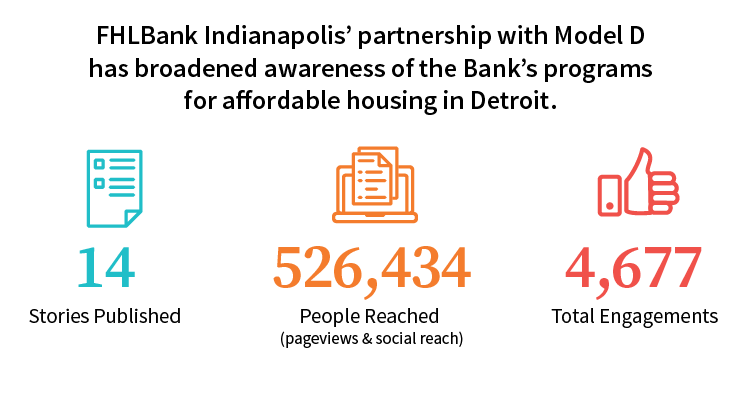
Monique Becker was featured in one of the articles. During the pandemic, she and her best friend and business partner Elyse Wolf received a $25,000 Elevate small business grant through FHLBank Indianapolis, using it to finish renovating a vacant two-family flat that they purchased at auction. Becker said she was excited to see that FHLBank Indianapolis was offering something for businesses in operation for more than one year, because most grants and financial resources are hard to get without a longer track record.
Becker and Wolf rent their properties at approximately 40 percent of the area median income, which makes them affordable homes. Although their business, Mona Lisa Living, is for-profit, there is a social mission behind their work, said Becker. “Development has a lot of negative connotations. We are doing development but also creating beautiful places to live and improving quality of life,” she said. When they buy property, Becker and Wolf take time to get to know the house, the land and the people, to get a sense of what should be there and what works best for the neighborhood.
By establishing a physical presence in Detroit, the Bank forged a commitment to the Detroit community and immediately began making a positive impact.
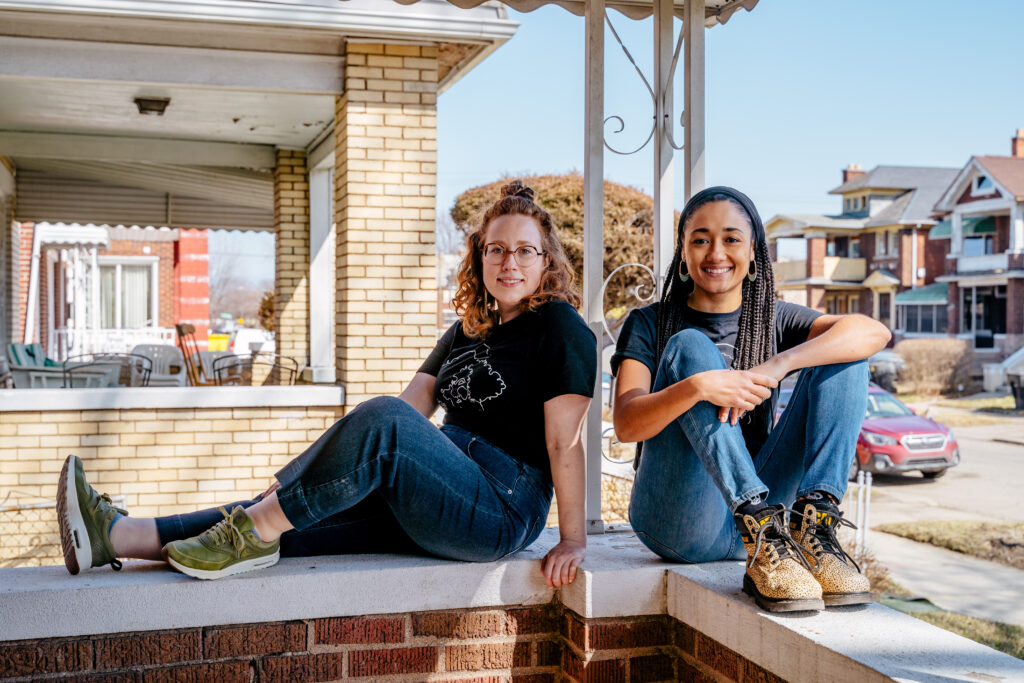

Neighbors Helping Neighbors
FHLBank Dallas responds to overwhelming community needs by increasing Partnership Grant Program funds.
Since 1996, the Federal Home Loan Bank of Dallas (FHLBank Dallas) has partnered with member institutions through the Partnership Grant Program (PGP) to provide financial support to community-based organizations involved with affordable housing and economic development throughout its district.
During economic turmoil caused by the COVID-19 pandemic, FHLBank Dallas saw urgent needs rising in the communities it serves and, in response, invested $2.4 million in PGP grant money, up from $300,000 in 2019, including an increase to its matching contributions. The Bank also expanded the use of funds to include social services like economic and rental assistance, shelter and housing and job training.
During Valentine’s Week in 2021, a winter storm hit Texas. Temperatures plummeted, and some power plants were unable to perform in the extreme cold, which caused widespread and sustained power outages. Houston was hit hard. Days without power caused water to freeze and expand, eventually bursting pipes for some unfortunate residents. Nearly half of Texas residents were without water for two days. Houston’s low-income, elderly and disabled residents suffered disproportionately.
This is where the Joseph House Community Outreach Center’s program leader, Dr. R.C. Stearns (known as Apostle Stearns), stepped in. Joseph House is a nonprofit organization that provides a variety of services for the poor and underserved populations of the City of Houston, Harris County, and surrounding areas, including minor home repairs for seniors. After the storm, Joseph House provided life-saving home repairs to restore running water and electricity to elderly and disabled Houston residents. Many of the residents it helped were in their late 80s or 90s.
Stearns said Joseph House relies significantly on partnerships and donations. Member institution Hancock Whitney Bank, in conjunction with FHLBank Dallas, gave the Joseph House Community Outreach Center $16,000 to help continue operations.
“It’s been a great partnership with good people to work with from the start of the application through the grant approval and funding process.”
— LaCarsha Babers, Community Development Officer at Hancock Whitney Bank
“We wouldn’t have been able to do it without the grant,” Stearns said. “The grant helped us retain and pay our staff in order to reach out to elderly residents who needed help.”
LaCarsha Babers is the Community Development Officer for Hancock Whitney Bank, which has collaborated with FHLBank Dallas to award PGP grant funding to over 22 nonprofit organizations across Texas and Louisiana since 2015.
“The grant funding has been a tremendous help in so many ways,” Babers said. “It’s been a great partnership with good people to work with from the start of the application through the grant approval and funding process.”
The February 2021 ice storm resulted in more than 200 fatalities across Texas. The PGP, via the support of FHLBank Dallas and Hancock Whitney Bank, allowed Joseph House to continue funding its operations, ensuring that it would be there to help some of Houston’s most vulnerable residents recover.
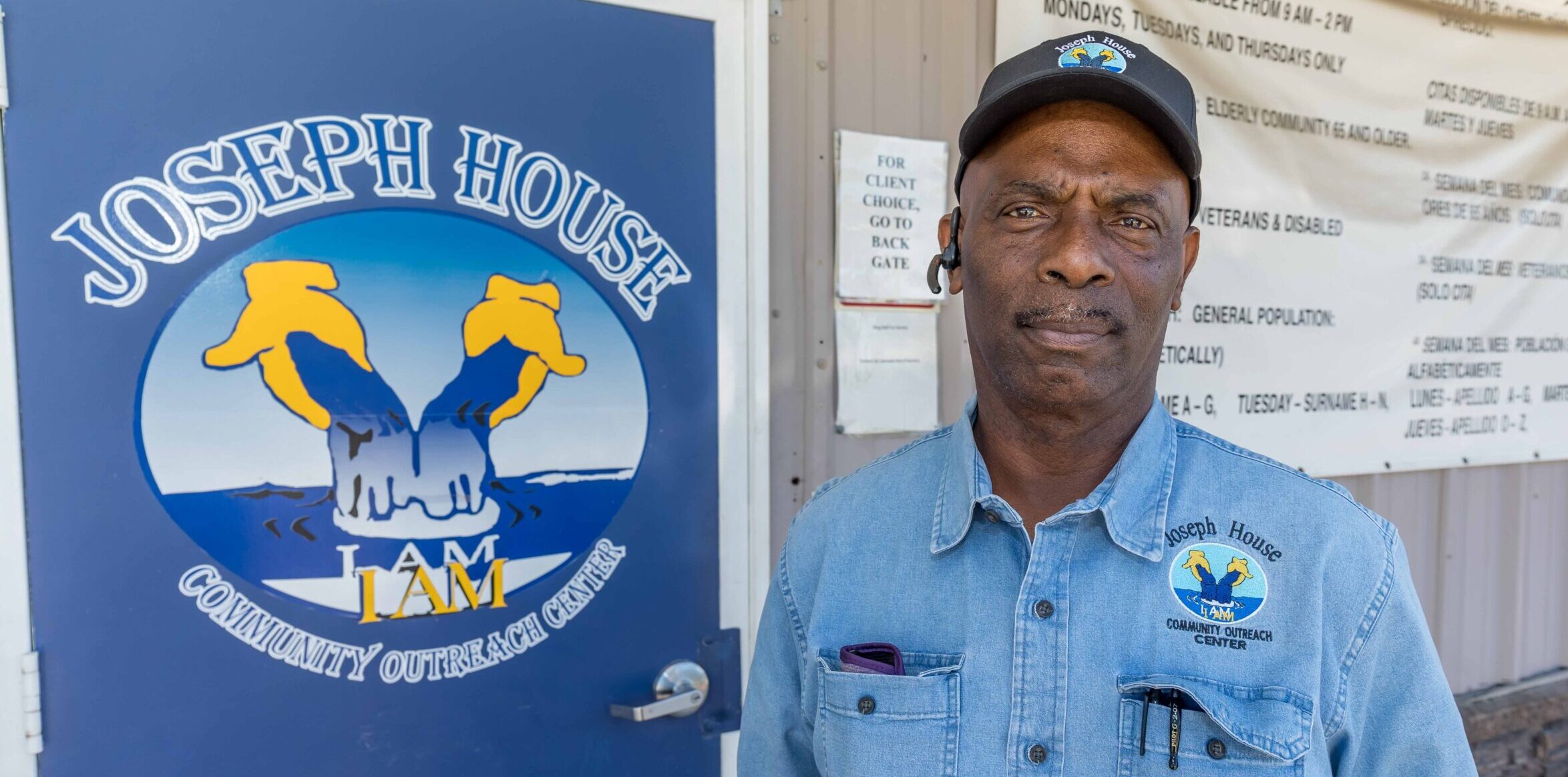
A Lifeline for Those in Need
FHLBank Cincinnati’s Housing Fund impacts the most vulnerable throughout the region.
Trudy Ford, 63, lived for nearly a year without a working bathroom in her 100-year-old home in Paducah, Kentucky, until a grant from the Federal Home Loan Bank of Cincinnati (FHLBank Cincinnati) Carol M. Peterson Housing Fund made it possible for her to get it repaired. Before that, she walked the half block to her son’s house or used a potty chair from her son’s camper.
She can laugh about it now that she has working plumbing, a structurally sound floor and a new shower (in place of the old tub). “As soon as they were done with the bathroom, I put that potty chair out on the porch and called my son. I said, ‘Come get your chair and I don’t ever want to see it again,’” she said with a laugh.
The Carol M. Peterson Housing Fund, or CMPHF, is a lifesaver to people like Ford. The fund offers up to $7,500 per home project for accessibility and emergency repairs for vulnerable residents in Kentucky, Ohio and Tennessee. The program was established in 2011 and has distributed more than $12.9 million for repairs to more than 2,000 homes. It is named after Carol M. Peterson (1938–2010), who led the Bank’s Housing and Community Investment Department for more than 20 years.
Nonprofit organizations, like the one Ford worked with, apply through FHLBank member institutions and coordinate repairs. Ford worked with the Paducah Alliance of Neighbors, which has been restoring homes for elderly and disabled Paducah residents since 2008. Demand is high in the Paducah area. Funds through the program are now committed within minutes of the application process opening, according to the Alliance’s Executive Director Sharon Poat. Poat has applied for funding through the CMPHF program since 2012 and has watched demand increase.
“We’re talking about people who are living on $10,000 to $12,000 a year,” Poat said. Ford received estimates of $6,000 for labor alone when she first inquired. She told the contractors not to bother coming back. Then she connected with Poat at the Alliance.
“Having the (CMPHF) program has enabled us to say to people, ‘let’s see what we can do to help.’”
— Sharon Poat, Executive Director, Paducah Alliance of Neighbors
A working bathroom enabled Ford to stay in her home, something she was determined to do even when her son offered to have her move in with him and his family. Keeping people in their homes and providing affordable housing are the Alliance’s goals. As Poat pointed out, it is cheaper for individuals and for the community to maintain existing houses than to tear them down and build new ones. “That’s important not just for those individual homeowners, but it also gets to be important for the community as a whole and for neighborhoods,” said Poat. Investing in house maintenance reduces homelessness and builds up the community, rather than tearing it down or displacing it.
The hardest part of Poat’s job is having to tell homeowners she can’t help them. “Having the (CMPHF) program has enabled us to say to people, ‘let’s see what we can do to help.’”
“I can’t think of a better way to honor the legacy and commitment of Mrs. Peterson to affordable housing than providing more than $14 million in grants so that over 2,500 families in Kentucky, Ohio and Tennessee can remain in their homes.”
— Damon Allen, FHLBank Cincinnati
Celebrating Diversity, Equity and Inclusion in Our Communities
FHLBank Topeka sponsored a community mural focused on diversity, equality, justice and inclusion in Topeka.
The Federal Home Loan Bank of Topeka (FHLBank Topeka) made possible a 130-by-30-foot mural near the site where the U.S. Supreme Court dismantled the legal framework for racial segregation in public schools with a $20,000 lead sponsorship to ArtsConnect Topeka. The mural stands as a monument to diversity, equality, justice and inclusion and as a symbol of community collaboration.
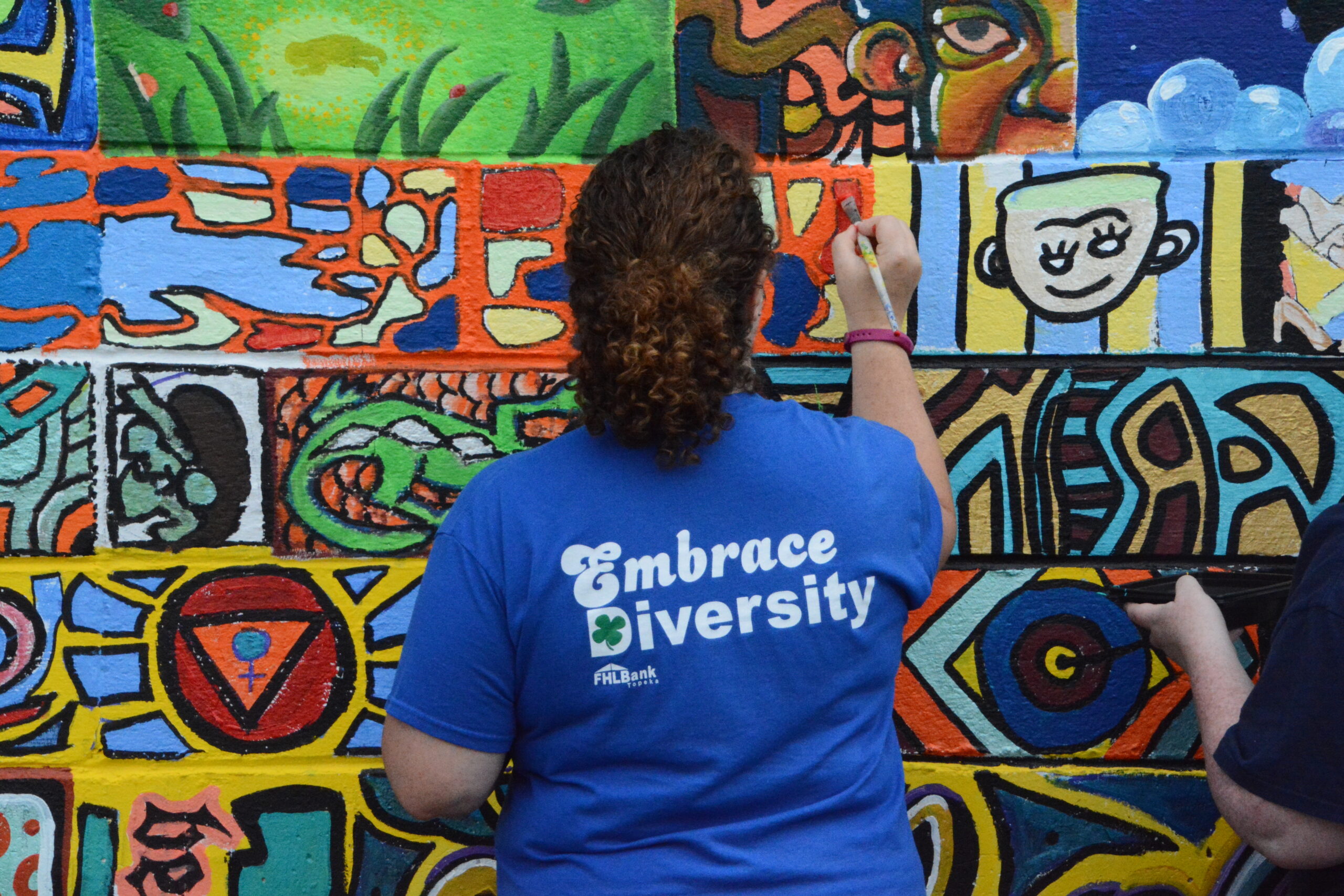
FHLBank Topeka is woven into the fabric of the Topeka community. The Bank has been a longtime supporter of local nonprofits, including Living the Dream, a nonprofit that helps preserve the legacy and example of Dr. Martin Luther King Jr. The Bank sponsored buses to transport school children to Living the Dream guest speakers and funded scholarships through the nonprofit. So, when ArtsConnect wanted to use children’s artwork from a Living the Dream contest for a community mural, turning to FHLBank Topeka seemed like a natural step.
Sarah Fizell, Executive Director of ArtsConnect, said the sponsorship from FHLBank Topeka saved the project. The mural, the largest ArtsConnect had created, would cost approximately $100,000, and in early discussions, people told Fizell it was “too big” and that it “can’t be done.” Enter FHLBank Topeka.
“It really was FHLBank Topeka’s investment in the project that made it possible for us to go forward and make it public.”
— Sarah Fizell, Executive Director of ArtsConnect
Fizell recalls doing a happy dance when she got the call and pledge from Amanda Kiefer, Senior Vice President and Chief Human Resources & Inclusion Officer at FHLBank Topeka. Fizell said, “It really was FHLBank Topeka’s investment in the project that made it possible for us to go forward and make it public.”
Funding from the Bank kickstarted the project. It helped pay for materials such as paint and tents and subsidized payments for 30 professional artists who created an outline from the children’s artwork. It also allowed ArtsConnect to hold community engagement events in support of the project.

In 2018, the mural was unveiled in front of more than 500 people, many of them community members who had painted sections of the mural. In total, more than 2,000 people from 34 states and nine countries helped paint. Some were out-of-towners visiting the historic site, others were schoolchildren from the Williams Science and Fine Arts Magnet School down the block, and still others were women from a nearby correctional facility. FHLBank Topeka’s employees volunteered to paint as well. “Our employees really enjoyed the opportunity to participate,” Kiefer said.
“We believe supporting the arts is supporting our employees and their families. It says to our potential recruits and our employees ‘we believe in you, we want this community to be great, we want your families to have all the opportunities they possibly can.’ We take the commitment to our community seriously.”
— Amanda Kiefer, Senior Vice President and Chief Human Resources & Inclusion Officer at FHLBank Topeka
ArtsConnect recognized the Bank with one of its annual Arty Awards, given to organizations and individuals that make Topeka stronger through the arts. Kiefer said the sponsorship was about art and so much more.
“We believe supporting the arts is supporting our employees and their families,” she said. “It says to our potential recruits and our employees ‘we believe in you, we want this community to be great, we want your families to have all the opportunities they possibly can.’ We take the commitment to our community seriously.”
The process of creating the mural was a profound demonstration of collaboration across community members and organizations. FHLBank Topeka is proud to have played a central role in bringing to Topeka a visual representation of its vibrant and diverse community.

